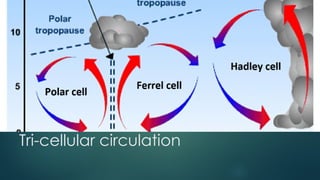global+air+circulation2.pdf
- 2. Unequal heating of the atmosphere  The solar energy from the sun is distributed uneven across the earth’s surface  Temperatures at the equator are high because incoming solar radiation is more intense as the sun’s energy is more concentrated  Temperatures at the poles are low as the incoming solar radiation is less intense as the sun’s energy is less concentrated  The difference in temperature causes Sibisi,2017
- 3. Atmospheric pressure Atmospheric pressure is the weight of the atmosphere above a given place
- 4. The relationship between air pressure and temperature  Due to high temperatures at the equator ,the rises up into the atmosphere. This creates low pressure .  low pressure is associated with high precipitation  Low temperatures at the poles causes the air to sink .this creates high pressure (Sibisi,2017)  High pressure is associated with cold dry conditions  The difference in temperature and air pressure causes the air to move horizontally and vertically  Forming global air circulation
- 5. Global pressure zones/belts Equatorial low pressure Subtropical high pressure Subpolar low pressure Polar high pressure
- 7. Equatorial low pressure . Mokgopa ,2021 Located at the equator (0 degrees N &S) Located at the equator (0 degrees N &S) Also known as the inter tropical convergence zone (ITCZ )Where trade winds meet. Also known as the inter tropical convergence zone (ITCZ )Where trade winds meet. Associated with Hadley cell Associated with Hadley cell Experiences warm and wet conditions Experiences warm and wet conditions
- 8. SUBTROPICAL HIGH pressure Rahman,2018 Located at 35 degrees north and south form as air above subtropics in pushed downward. Associated with f Experiences hot dry conditions
- 9. Sub- Polar Low Pressure Saloni,& Rahman,2018 It extends 60°N and 60°S of Equator. Air converges and rises Associated with tropical westerlies’ Associated with cool and moist conditions
- 10. Polar high pressure Mokgopa ,2021 Located at 90 degrees North & South Associated with the polar cell Air diverges and sinks Associated with polar easterlies
- 12. Hadley cell  between the equator and 30 degrees N and S .  warm air rises near the equator, cools as it travels toward the poles at high altitude, sinks as cold air, and warms as it travels towards the equator(Rahman,2018) .  Produces trade winds, jet streams and hurricanes. Cresnick,2010
- 13. Ferrel cell  Located between 30 and 60degrees north and south of the equator  Associated with high pressure  Descending air warms by compression giving cloudless and stable conditions Rahman,2018
- 14. Polar cell ÔÉò LOCATED BETWEEN 60 AND 90 DEGREES N AND S ÔÉò COLD AIR SINKS CAUSING HIGH PRESSURE ÔÉò ASSOCIATED WITH STABLE COLD CONDITIONS Rahman,2018
- 15. References Cresnick.(2010).ch18 winds students. Available at deshare.net/cresnick/ch18windsstudent? qid=2fb178a2-4ea4-48ab-b22c-4b4e53984fbf&v=&b=&from_search=2 .accessed on 20 august 2022. Mokgopa,T.(2021).Global air circulation. Available at:/TsiamoMokgopa/global-air-circulation-250516149 .Accessed on 20 august 2022. Rahman,K.(2018). General Circulation of the Atmosphere. available at: /KhalilurRahman63/genaral-circulation-of-the- atmosphere.Accessed on 20 august 2022. Saloni777.(2018).pressure and winds grade11 geography. Available at /Saloni777/pressure-and-winds-11-class-geography. Sibisi,N.(2017). Global air circulation. available at: /nhlanhlasibisi2/global-air-circulation. Accessed on 20 august 2022.
- 16. The end.
















